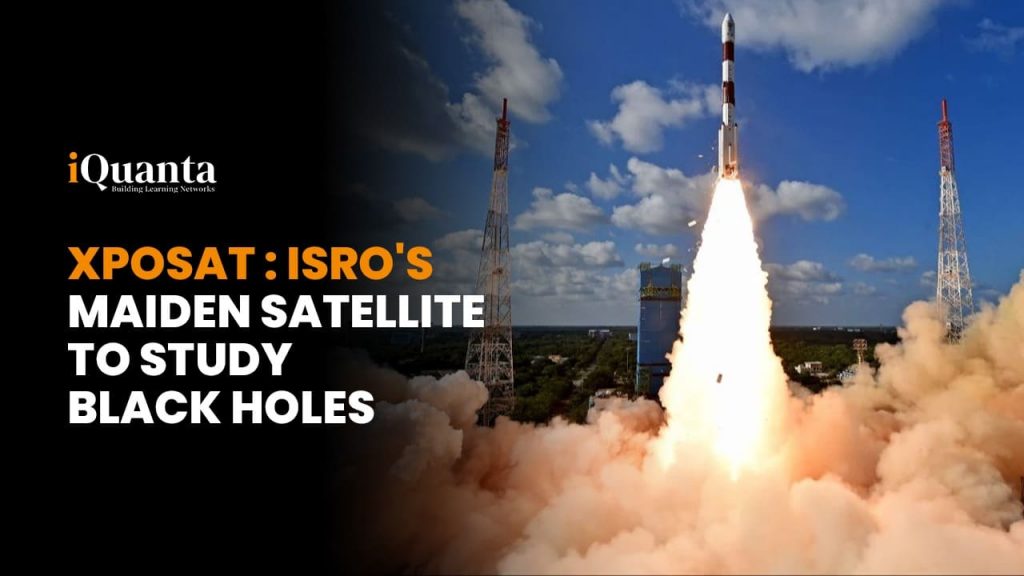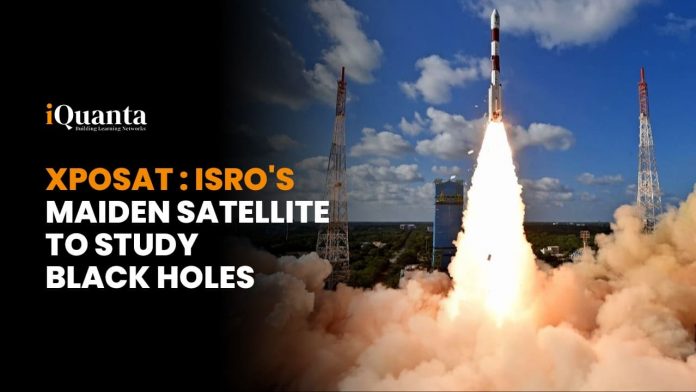
Genre : Science & Technology
The first X-Ray Polarimeter Satellite (XPoSat), which will aid in the study of astronomical objects like black holes, was launched by the ISRO (Indian Space Research Organisation) on Monday to celebrate the start of the new year. The Raman Research Institute (RRI) and the U R Rao Satellite Centre (URSC) worked closely together to develop the telescope. According to ISRO, by observing space events over a wide energy range of 2-30 keV, this mission would supplement the efforts of US space agency NASA, which launched its Imaging X-ray Polarimetry Explorer (IXPE) in 2021.
Launched from the first launch pad at the Sriharikota spaceport, the agency’s reliable PSLV-C58 rocket carried the XPoSat and ten other satellites into orbit at 9.10 am.

XPoSat
The first specifically designed ISRO scientific satellite, XPoSat, is used to conduct studies on space-based polarization measurements of X-ray radiation from astronomical sources. The main goal is to gain knowledge on the polarization of space-based powerful X-ray sources.
The two payloads on board XPoSat are XSPECT (X-ray Spectroscopy and Timing) and POLIX (Polarimeter Instrument in X-Rays).
POLIX will assist in measuring the polarization of X-rays in the 8-30keV energy band that are emitted by approximately 50 possible cosmic sources using Thomson Scattering, according to the ISRO. An essential diagnostic tool for analysing the geometry and emission process of astronomical sources is the X-ray polarisation.
Conducting spectroscopic and polarization measurements of X-ray emissions from cosmic sources is one of the mission’s other goals. There are around five years in a mission.
The primary satellite would be launched by the 44.4-meter-tall PSLV (Polar Satellite Launch Vehicle) rocket into a 650 km Low Earth Orbit approximately 21 minutes after liftoff. Later, the scientists would restart the fourth stage of the vehicle to lower the satellite to a lower altitude of about 350 km in order to conduct the PSLV Orbital Experimental Module-3 (POEM-3) experiment.
Significance of mission
The ISRO claims that the mission will have a significant positive impact on the international astronomy community. Beyond its potential for timing and spectroscopy-based investigations, the knowledge gained from X-ray polarisation measurements of objects in space, such as active galactic nuclei, neutron stars, and black holes, could lead to a substantial advancement in our comprehension of their physics. It will also contribute to India’s growing X-ray polarimetry capabilities.
In addition to ISRO, NASA carried out a comparable investigation on the leftovers of supernova explosions, black hole particle streams, and other cosmic occurrences two years ago.
Expected Contributions
- XPoSat will contribute to the understanding of the complex structure and behaviour of strong magnetic fields surrounding black holes and neutron stars by detecting the polarization of X-rays.
- Investigations into the polarization of X-rays from supernova remnants and active galactic nuclei can shed light on the principles behind explosions and accretion processes, respectively.
- XPoSat can distinguish between several X-ray producing processes, such as thermal emission, electron-positron annihilation, and synchrotron radiation. Studying sources such as galaxy clusters and pulsar wind nebulae requires an understanding of this dichotomy.
- Understanding how X-ray polarization changes over a range of energy levels will provide insights into the geometry and physical parameters of the emission zones.
Other Payloads
Radiation Shielding Experiment Module developed by TakeMe2Space, Women Engineered Satellite by LBS Institute of Technology for Women, BeliefSat (an amateur radio satellite) built by K J Somaiya Institute of Technology, Green Impulse Transmitter by Inspecity Space Labs Pvt Ltd, LEATTD— Launching Expeditions for Aspiring Technologies Technology Demonstrator by Dhruva Space Pvt Ltd, RUDRA 0.3HPGP and ARKA 200 developed by Bellatrix Aerospace Pvt Ltd, Dust Experiment (DEX) built by PRL, ISRO and Fuel Cell Power System, and Si based High Energy cell built by Vikram Sarabhai Space Center are among the payloads.

